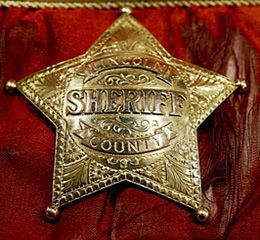By John Koopman, San Francisco Chronicle
Pat Garrett’s badge was born in blood.
The star was made of gold and given to the legendary lawman after he shot and killed the one of the most famous outlaws in the old west: William H. Bonney. Better known as Billy the Kid.
Badge presented to Pat Garrett by newspaperman A.J. Fountain in 1881. (Photo by Katy Raddatz, San Francisco Chronicle) |
Later, the man who gave the badge to Garrett disappeared and was presumed murdered along with his young son. Garrett, too, died from a bullet during a land dispute. Garrett’s killer died at the hands of a lynch mob.
It’s that history - that link to a storied past - that brings out the collectors, and their pocketbooks.
Garrett’s badge was part of a large collection of peace officers’ badges that went on the block Monday at Greg Martin Auctions. Another badge in the collection, one that used to belong to the Stockton police chief, went for $32,000.
Garrett’s badge fetched $100,000.
“I think it’s a steal,” said the winning bidder, Arnold Duke of Rockville, Md. “I would have started sweating if it had gone above $150,000.”
Duke said he has been amassing a large collection of material related to the Lincoln County war in New Mexico in the 1870s, because he plans to open a museum in the city of Ruidoso.
The badge will be the centerpiece of his collection, he said.
“It is an absolutely priceless piece of Western memorabilia,” Duke said in a telephone interview from Maryland. “It is the only one of its kind in the world.”
Garrett’s badge came in its original case, the fabric inside tattered from use. The badge has five points and an inscription on the back that says, “To Pat Garrett. With the best regards of A.J. Fountain. 1881.”
Fountain was a prominent newspaperman who organized a militia and later became a judge. He and his 8-year-old son disappeared, and Garrett was called out of retirement to solve the crime. The men accused of killing the two were acquitted, and the bodies were never found.
The bidding Monday was quiet, and without much of the emotion and intensity that can make auctions exciting. A handful of bidders sat in chairs in the middle of the auction house, while employees took bids over the phone and Internet.
The bidding on Garrett’s badge started at $50,000. It rose quickly and turned into a competition between two phone bidders. The entire exchange took about a minute and a half.
Glenn Chrisman, who works part-time for the auction house, said he cannot explain the mind of the collector. Different people do it for different reasons, he said. Some are fascinated by a single thing, like a particular weapon, and they collect every known variation of it. Others just like to feel that connection to the past. They can touch, own or even use the same items and implements used by individuals dozens or hundreds or thousands of years ago.
“I think of it as three-dimensional works of art,” said Martin, who has been buying and selling collectibles since he bought his first gun at age 12. He paid $10 only to find out it was worth about $125.
The auction house also sold Garrett’s .44-caliber rifle, which had a shortened barrel and broken stock. The stock, which bears Garrett’s brand, was fixed with a rawhide band. It looks a little rough around the edges, but Martin said it was in firing condition. The price on Monday: $30,000.
Martin said guns usually sell for more than badges. He once sold the most expensive gun in the world, an 1849 decorative revolver, for $828,000. But the Garrett badge was special, he said.
“That’s the world’s greatest badge.”


